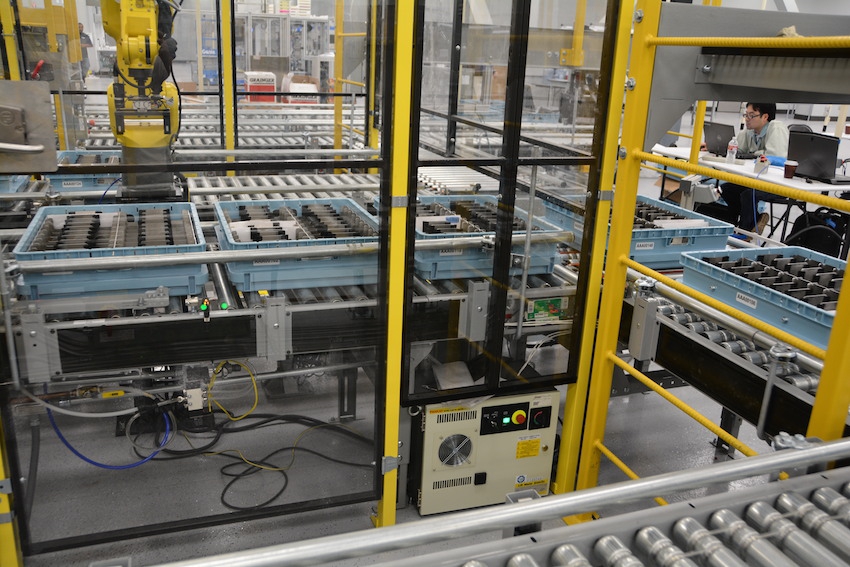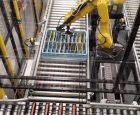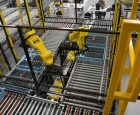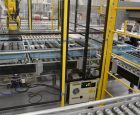
VSP Optics Group shortens production time with new Daifuku system
November 15, 2016
By Ron Schumner Wynright Corp

Nov. 15, 2016 – VSP Optics Group provides ophthalmic technology, lens products and lab services that aim to strengthen patient experience and promote practice growth. Its portfolio of customized lens products claim to be the fastest growing lens brand in the optical industry, and in the midst of its tremendous growth, the company reached out to Wynright’s engineering and software controls team to turn its manufacturing objectives into reality.
The challenge
Online and mega optical labs promise rapid delivery, driving a new standard in the mature and active market. This is causing optical laboratory businesses, such as VSP Optics Group, to rethink the processes they use to manufacture eyewear.
Although the lab could immediately receive a lens prescription electronically, it typically wouldn’t receive frames from an optometrist’s office for 24-48 hours. Rather than wait, VSP concluded it could compress the process by starting on the lenses as soon as it received the order, resulting in a 1-2 day jump on the process. However, there was still one key problem — storing the surfaced lenses until they could be matched with the right frame when it arrives.
Previous manual efforts became increasingly complicated and labour-intensive as volume increased, requiring up to 30 people in the new environment. VSP wanted to look for a more cost-efficient, automated solution.
The solution
Wynright logistics engineers designed a postponing, work-in-process strategy, in which items are stored and retrieved automatically until they are needed for various stages of the production process. The strategy involves placing lens materials or frames in plastic totes, where they are conveyed between an automated storage facility then onto various human and robotic assembly stations.
Wynright specified a Daifuku H-MS mini-load storage and retrieval system, providing high density storage that maximizes use of available cube space. The system can handle 26,000 frames and lenses at a time.
The laboratory uses state-of-the-art digital surfacing equipment that produces extremely precise prescription lenses which receive various enhancements including anti-reflective coatings, sunglass and fashion tints. Next, the lenses are sent to the Daifuku H-MS to be matched up with the frame, dispatched from the eye doctor’s practice.
When the frames arrive, associates measure them for size and shape, and place them into a barcode-labelled envelope and induct them into the automated system where they are matched to the corresponding lenses stored in the system or stored until the lenses are completed. The system does not care if it is storing or retrieving lenses or frames, it just looks to see if the match is already in the system. The lenses are usually done before the frames arrive, but if the frame arrives first, it is stored until the lenses are ready. Operators scan the lenses or frame envelopes and the system dictates whether to place the item in a tote for matching or a different tote for storage.
The robot at the first station removes an envelope from the tote and places it in a separate container at a lower level. The tote on that lower level advances to the other robot station, where the robot removes the envelope with the matching item and deposits it in the lower tote that holds the lenses. This tote, which now holds both the lenses and frame, advances to a station where the matching pair is manually picked and staged prior to going into a finishing operation. Then, the lenses are cut down to size and mounted in the frame. Finally, they end up at final inspection where the prescription is verified and the finished product is ready to be shipped back to the optometrist.
The process is complex and requires precision timing. Although humans are involved at the front and back end of the process, everything else is fully software-driven by the warehouse execution system (WES). The software keeps a location track of all 26,000 pieces — this is done as a manual consolidation process and synchronizes the delivery of the right lenses and frames to the robotic piece-picking station.
The outcome
Completed 18 to 24 months ago, the upgrade allows the team to start working on a pair of glasses as much as 24 hours earlier than in the past, reducing the delivery time of a finished pair of glasses from three to 3.5 days to two to 2.5 days.
To accommodate future expansion, anticipated growth rates were analyzed and the system was laid out with enough room to add two additional aisles in the future.
Ron Schumner is an account executive at Wynright Corporation. He joined the company four years ago and has more than 25 years of engineering and operations experience in the medical device and food industry. In his role, Schumner is responsible for equipment maintenance, contracts and coordination with vendors and service personnel, and coordinates the management of technical aspects and safety requirements.
Advertisement
- Ultrafast lasers offer great promise as a unique manufacturing tool
- Keba launches redesigned website



